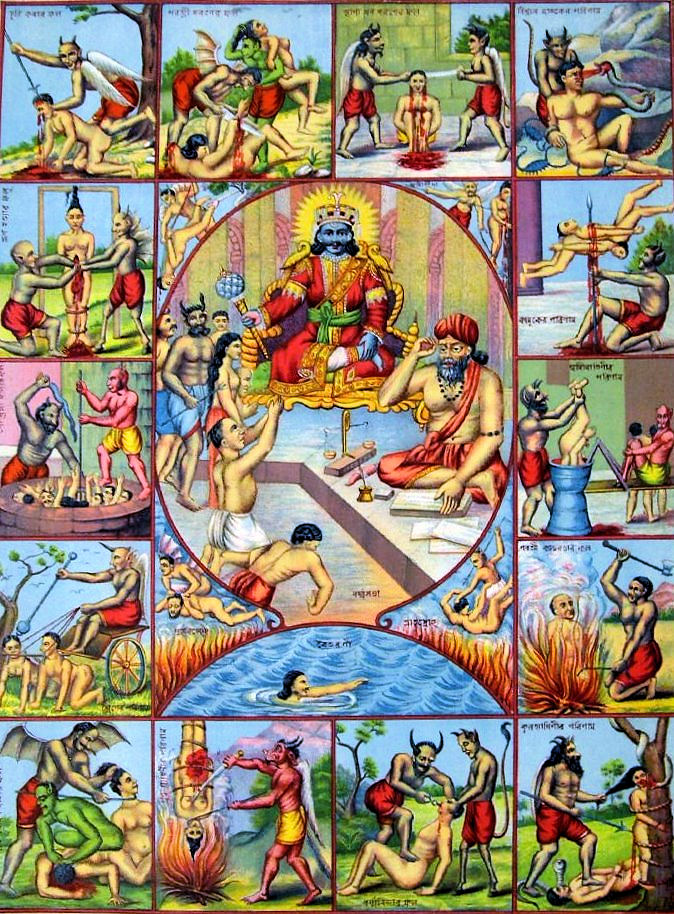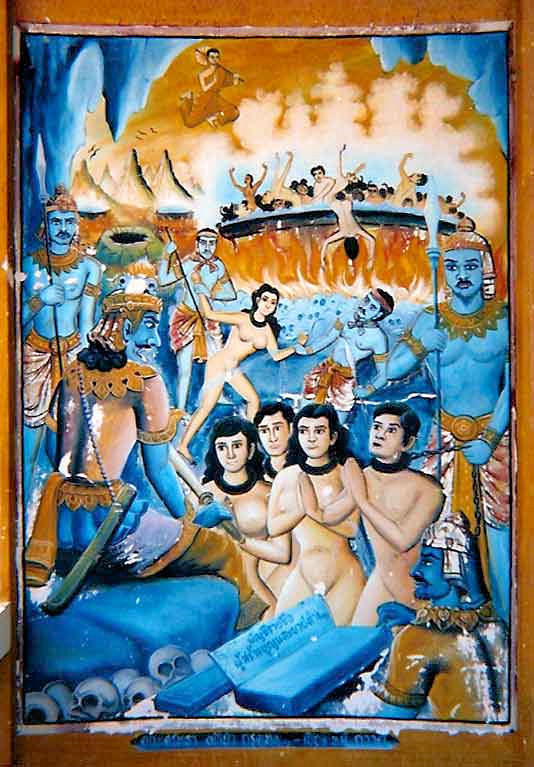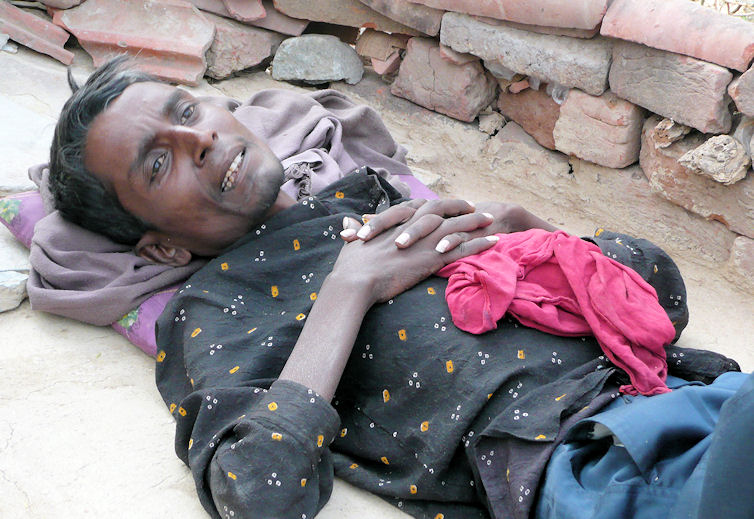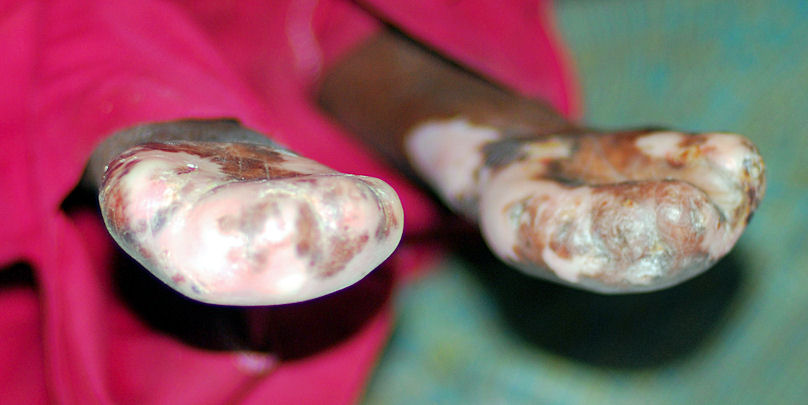|
Meinem Lehrer und Freund Prof. Dr. Heinrich von Stietencron in Dankbarkeit gewidmet. |
Zitierweise | cite as: Amarasiṃha <6./8. Jhdt. n. Chr.>: Nāmaliṅgānuśāsana (Amarakośa) / übersetzt von Alois Payer <1944 - >. -- 1. Prathamam kāṇḍam. -- 10. narakavargaḥ. -- Fassung vom 2010-09-09. -- URL: http://www.payer.de/amarakosa/amara110.htm
Erstmals hier publiziert: 2010-09-09
Überarbeitungen:
©opyright: Creative Commons Lizenz (Namensnennung, keine kommerzielle Nutzung, share alike)
Dieser Text ist Teil der Abteilung Sanskrit von Tüpfli's Global Village Library
|
Meinem Lehrer und Freund Prof. Dr. Heinrich von Stietencron in Dankbarkeit gewidmet. |
Falls Sie die diakritischen Zeichen nicht dargestellt bekommen, installieren Sie eine Schrift mit Diakritika wie z.B. Tahoma.
Die Devanāgarī-Zeichen sind in Unicode kodiert. Sie benötigen also eine Unicode-Devanāgarī-Schrift.
Jātarūpa
Jātarūpa <vor 1119 n. Chr.>: Jātarūpa's Commentary on the Amarakoṣa : for the first time critically edited together with an introduction, appendices and indices / Mahes Raj Pant. - 2 Bde. -- Delhi [u.a.] : Motilal Banarsidass, 2000. -- Teilw. zugl.: Hamburg, Univ., Diss. von Mahes Raj Pant. -- ISBN 81-208-1690-0
1. a./b. syān nārakas tu narako nirayo durgatiḥ striyām
स्यान् नारकस् तु नरको निरयो दुर्गतिः स्त्रियाम् ।१ क।
[Bezeichnungen für Hölle sind:]
Erläuterungen:
1 नरक m.: Hölle
"NARAKA. 'Hell' ; a place of torture to which the souls of the wicked are sent. Manu enumerates twenty-one hells : Tāmisra, Andha-tāmisra, Mahā-raurava, Raurava, Karaka, Kālasūtra, Mahā-naraka, Saṃjīvana, Mahā-vīci, Tapana, Sampratāpana, Saṃhāta, Sakākola, Kuḍmala, Pūti-mṛttika, Loha-śanku, Ṛjisha, Panthāna, Śālmali, Asi-patra-vana, and Loha-dāraka. Other authorities vary greatly as to the numbers and names of the hells. See Viṣṇu Purāṇa, ii. 214."
[Quelle: Dowson, John <1820-1881>: A classical dictionary of Hindu mythology and religion, geography, history, and literature. -- London, Trübner, 1879. -- s.v.]

Abb.: नरकाः । ca. 1895
"Album of popular prints mounted on cloth pages. Colour lithograph, lettered, inscribed and numbered 11. A large central panel portrays Yama the god of death (often referred to as Dharma) seated on a throne; to the left stands a demon. To the right of Yama sits Chitragupta, assigned with keeping detailed records of every human being and upon their death deciding how they are to be reincarnated, depending on their previous actions. A woman and two men await their judgement. The rest of the print is compartmentalised into fourteen smaller panels, and each image portrays a different way demons torture sinners. These vary from being pierced by a spear, to having your entrails removed. Bengali inscriptions detail each occurrence."
[Bildquelle: Wikipedia. -- Public domain]
2 निरय m.: "Untergang", Hölle, Kummer, Sünde
Zum Vergleich: Höllen im Theravādabuddhismus:
"Niraya (hell) Various lists of Nirayas are found in the books. In the Jātaka Commentary* occurs the following:
- Sañjīva,
- Kālasutta,
- Sanghāta,
- Jālaroruva,
- Dhūmaroruva,
- Mahāvīci,
- Tapana,
- Patāpana.
The Samyutta and Anguttara Nikāyas and the Sutta Nipāta contain a different list:
- Abbuda,
- Nirabbuda,
- Ababa,
- Atata,
- Ahaha,
- Kumuda,
- Sogandhika,
- Uppala,
- Pundarīka,
- Paduma (S.i.149; A.v.173; SN.p.126; see also Dvy. 67).
The Commentaries explain (E.g., AA.ii.853) that these are not separate Nirayas but specified periods of suffering in Avīci. The Devadūta Sutta (M.iii.185) of the Majjhima Nikāya contains yet another list:
- Gūtha,
- Kukkula,
- Simbalivana,
- Asipattavana and
- Khārodakanadī.
Other names, also, occur sporadically e.g.,
- Khuradhāra (J.v.269),
- Kākola (J.vi.247),
- Sataporisa (J.v.269) and
- Sattisūla (J.v.143).
The most fearful of the Nirayas is, however, the Avīci-mahā-niraya (see s.v. Avīci).
* J.v.266, 271; the same list is found in Dvy.67, except that Raurava is substituted for Jalaroruva and Mahāraurava for Dhūmaroruva. "
[Quelle: Malalasekera, G. P. <1899 - 1973>: Dictionary of Pāli proper names. -- Nachdruck der Ausgabe 1938. -- London : Pali Text Society, 1974. -- 2 vol. -- 1163, 1370 S. -- ISBN 0860132692. -- s.v.]
1. c./d. tadbhedās tapanāvīci-mahāraurava-rauravāḥ
2. a/b. saṃghātaḥ kālasūtraṃ cetyādyāḥ
sattvās tu nārakāḥ
तद्भेदाष् तपनावीचि-महारौरव-रौरवाः ॥१ ख।
संघातः कालसूत्रं चेत्याद्याः सत्त्वास् तु
नारकाः ।२ क।
Die verschiedenen Höllen heißen:
Erläuterungen:

Abb.: Buddhistische Höllenvorstellung, Malerei in Tempel,
Thailand
[Bildquelle: Wikipedia. -- Public domain]
Diese Höllen kommen auch in der buddhistischen Literatur vor, darum die folgenden Erklärungen aus Malalasekara's Dictionary:
1 तपन m.: "Brennender", Tapana
"Tapana.-A Niraya. Beings born there are pierced by heated stakes and they remain transfixed, motionless. J.v.266, 271, 275." [Quelle: Malalasekera, G. P. <1899 - 1973>: Dictionary of Pāli proper names. -- Nachdruck der Ausgabe 1938. -- London : Pali Text Society, 1974. -- 2 vol. -- 1163, 1370 S. -- ISBN 0860132692. -- s.v.]
2 अवीचि m.: "ohne Wellen", Avīci
"Avīci. One of the eight great purgatories (mahāniraya) (J.v.266). It is ten thousand leagues in extent and forms part of a cakkavāla (SnA.ii.443). The Milindapañha (p.5), however, places it outside the sphere of the earth. Spence Hardy (Manual of Buddhism, p.26) mentions a tradition which says that Avīci is seven hundred miles directly under the Bodhi Tree at Gaya. In later books, e.g. the Dhammapada Commentary, it is represented as being under the earth, for we are told that the earth opened wide to allow the flames of Avīci to escape and to drag down sinners into its bowels (E.g., DhA.i.127, 147; iii.181). It seems to have been specially designed for those who had committed very grievous crimes, among whom are
- Devadatta;
- Cunda, the pork butcher;
- Ananda, who raped his cousin the Therī Uppalavannā;
- the ascetic Jambuka, who in a previous birth had insulted an arahant;
- the murderer of the Pacceka Buddha Sunetta;
- Sīvalī, who in a former birth had blockaded a city for seven years;
- Suppabuddha, who insulted the Buddha;
- Mallikkā, because of her misbehaviour with a dog (she was only there seven days);
- Ciñcā-Mānavikā, because she falsely accused the Buddha;
- and Kapila, brother of Sodhana, for reviling pious monks.
For details and references see under these names; see also Mil.357.
According to Buddhaghosa, Avīci is often called Mahā Niraya (AA.i.376). Descriptions of it are to be found in several places in the four Nikāyas (E.g., M.iii.183; A.i.141-2). It is a quadrangular space, one hundred leagues each way, four-doored, walled all round and above with steel and with floor of incandescent molten steel.
The Dhammapadatthakathā gives a description of the tortures that await the entrant to Avīci. When, for instance, Devadatta entered there, his body became one hundred leagues in height, his head, as far as the outer ear, entered into an iron skull; his feet sank up to the ankles in iron, an iron stake as thick as the trunk of a palmyra tree came from the west wall, pierced the small of his back and, penetrating his breast, entered the east wall. Other similar stakes came from the south and from the north and transfixed him (DhA.i.148).
The fire of Avīci is so powerful that it destroys the eyes of anyone looking at it from a distance of one hundred leagues (A.i.142). It would destroy in a moment a rock as large as a gabled house, yet beings born there remain undestroyed, as though reposing in their mother's womb (DhA.i.127; Mil.67).
Beings born in Avīci suffer for periods of varying lengths; thus, Mallikā, Pasenadi's queen, remained only for seven days (DhA.iii.121), while Devadatta is destined to pass there 100,000 kappas (DhA.i.148).
The Sutta Nipata (p.126) gives the names of various specified periods of suffering, which, according to Buddhaghosa (SnA.i.476), are to be spent in Avīci; they are Abbuda, Nirabbuda, Ababa, Ahaha, Atata, Kumuda, Sogandhika, Uppalaka, Pundarīka, and Paduma, taken in a geometrical progression of twenty (i.e. twenty Abbudas=one Nirabbuda, etc.).
Another mode of suffering in Avīci is described as Sarājita (SA.iii.100).
It is noteworthy that the word Avīci occurs only once in the four Nikāyas - namely, in a passage in the Cakkavatti-Sīhānāda Sutta of the Digha Nikāya (D.iii.75; repeated in A.i.159) - but in this context there is no indication that the name refers to a purgatory. The word is not found in a list of purgatories given in the Sutta Nipāta (pp.126-31) and in the Samyutta (i.152). It is, however, found in a poem in the Itivuttaka (No. 89) which recurs both in the Vinaya (ii.203) and in the Dhammasangani (Section 1280), and there it is specifically called a niraya.
In the Digha passage mentioned above, the reference to Avīci is in connection with a tremendous growth of population which will occur in Jambudīpa in a future age. Houses will be so close that a cock could fly from any one to the next, and one would think it Avīci (avīci maññe).
Rhys Davids suggests (Dial.iii.73, n.1) that the word (which he translates as Waveless Deep) might have been originally used to denote density of population. Buddhaghosa (DA.iii.855) explains it as "nirantara-pūrita" perhaps in the sense that it is filled with fire. In the Visuddhi Magga (ii.449) the word appears to be a synonym for jars (disintegration) and is used in connection with the disintegration of earth, water, mountains, sun, moon, etc.
Avīci is often referred to as the lowest point of the universe (Thus, e.g.,Vsm.ii.390, 486; Mbv.57).
The chief suffering endured there is that of heat (MNidA., p.8)."
[Quelle: Malalasekera, G. P. <1899 - 1973>: Dictionary of Pāli proper names. -- Nachdruck der Ausgabe 1938. -- London : Pali Text Society, 1974. -- 2 vol. -- 1163, 1370 S. -- ISBN 0860132692. -- s.v.]
3 रौरव m.: "Geschrei", Raurava
"Roruva. A Niraya. Beings were presumably born there as a result of
- casting aspersions on the Dhamma (S.i.30)
- miserliness (e.g., J.iii.299)
- adultery (J.vi.237)
Sometimes (J.v.266) two Roruvas are mentioned which the scholiast (J.v.271) explains as being Jālaroruva and Dhūmaroruva; in the first beings have red hot flames blown into their bodies, and in the second, noxious gases (khāradhūma).
Buddhaghosa says (SA.i.64) that Jālaroruva is another name for Avīci, and that the Niraya is so called because beings shout while being burnt there (aggimhi jalante punappunam ravanti)."
[Quelle: Malalasekera, G. P. <1899 - 1973>: Dictionary of Pāli proper names. -- Nachdruck der Ausgabe 1938. -- London : Pali Text Society, 1974. -- 2 vol. -- 1163, 1370 S. -- ISBN 0860132692. -- s.v.]
4 संघात m.: "Zusammenschlagen", Saṃghāta
"Sanghāta. A Niraya. It is so called because massive rocks of heated iron meet and crush the victims. J.v.256, 270." [Quelle: Malalasekera, G. P. <1899 - 1973>: Dictionary of Pāli proper names. -- Nachdruck der Ausgabe 1938. -- London : Pali Text Society, 1974. -- 2 vol. -- 1163, 1370 S. -- ISBN 0860132692. -- s.v.]
5 कालसूत्र n.: "blauschwarze Schnur", Angelschnur, Kālasūtra
"Kālasutta.-One of the principal hells (J.v.266, 267, 268). Beings born there are placed on a floor of heated iron, marked with a black thread made red hot, and then cut into pieces along the markings (J.v.270)." [Quelle: Malalasekera, G. P. <1899 - 1973>: Dictionary of Pāli proper names. -- Nachdruck der Ausgabe 1938. -- London : Pali Text Society, 1974. -- 2 vol. -- 1163, 1370 S. -- ISBN 0860132692. -- s.v.]
2. saṃghātaḥ kālasūtraṃ cetyādyāḥ sattvās tu nārakāḥ
pretā vaitaraṇī sindhuḥ syād alakṣmīstu nirrtiḥ
संघातः कालसूत्रं चेत्याद्याः
सत्त्वास् तु नारकाः ।
प्रेता वैतरणी सिन्धुः स्याद् अलक्ष्मीस् तु
निरृतिः ॥२॥
Die Höllenwesen heißen
Erläuterungen:
1 प्रेत m.: Weggegangener, Verstorbener, Totengespenst
"PRETA. A ghost ; an evil spirit animating a dead carcase, and haunting cemeteries and other places."
[Quelle: Dowson, John <1820-1881>: A classical dictionary of Hindu mythology and religion, geography, history, and literature. -- London, Trübner, 1879. -- s.v.]
2. c./d. pretā vaitaraṇī sindhuḥ syād alakṣmīs tu nirrtiḥ
प्रेता वैतरणी सिन्धुः स्याद् अलक्ष्मीस् तु निरृतिः ॥२ ख॥
Der Höllenfluss heißt वैतरणी f.: "Überquerung", Vaitaraṇī1
Erläuterungen:
1 वैतरणी f.: "Überquerung", Vaitaraṇī
"VAITARAṆĪ. '(The river) to be crossed' , that is, the river of hell, which must be crossed before the infernal regions can be entered. This river is described as being filled with blood, ordure, and all sorts of filth, and to run with great impetuosity."
[Quelle: Dowson, John <1820-1881>: A classical dictionary of Hindu mythology and religion, geography, history, and literature. -- London, Trübner, 1879. -- s.v.]
2. c./d. pretā vaitaraṇī sindhuḥ syād alakṣmīs tu nirrtiḥ
प्रेता वैतरणी सिन्धुः स्याद् अलक्ष्मीस् तु निरृतिः ॥२ ख॥
[Bezeichnungen für die Göttin des Verderbens / des Todes sind:]
Erläuterungen:
1 निरृति f.: Untergang, Tod, Nirṛti
"NIRṚTI. 'Death, decay'. Death personified as a goddess ; sometimes regarded as the wife and sometimes as the daughter of A-dharma. One of the Rudras." [Quelle: Dowson, John <1820-1881>: A classical dictionary of Hindu mythology and religion, geography, history, and literature. -- London, Trübner, 1879. -- s.v.]
3. a./ b. viṣṭir ājūḥ kāraṇā tu yātanā tīvravedanā
विष्टिर् आजूः कारणा तु यातना तीव्रवेदना ।३ क।
[Bezeichnungen für Frondienst / Zwangsarbeit (nicht nur in der Hölle) sind:]
आजू / आजुर् f.: Zwangsarbeit (?), "Steht an beiden Orten [im Amarakośa] im Kapitel, das von der Hölle handelt und wird mannigfach gedeutet: nicht bezahlte Arbeit, das zur-Hölle-Befördern us.w. (s. विष्टि). Auch die Form आजू wird angeführt. Das Wort scheint auf जर् (जॄ) zurückzugehen, so das man eine Bedeutung wie gebrechliches Alter vermuten könnte." (PW s. v.)

Abb.: विष्टिः ।
[Bildquelle:
Oxfam
International. --
http://www.flickr.com/photos/oxfam/3881286318/. -- Zugriff am 2010-09-09. --
Creative
Commons Lizenz (Namensnennung, keine kommerzielle Nutzung, keine
Bearbeitung)]
3. viṣṭir ājūḥ kāraṇā tu yātanā tīvravedanā
pīḍā bādhā vyathā duḥkham āmanasyaṃ prasūtijam
4. syāt kaṣṭaṃ kṛcchram ābhīlaṃ triṣv eṣāṃ bhedyagāmi yat
विष्टिर् आजूः
कारणा तु यातना तीव्रवेदना ।
पीडा बाधा व्यथा दुःखं आमनस्यं प्रसूतिजम् ॥३॥
स्यात् कष्टं कृच्छ्रम् आभीलं त्रिष्व् एषां भेद्यगामि यत् ॥४॥
[Bezeichnungen für schweres Leiden sind:]
[Bezeichnungen für Leid sind:]
Als Adjektive haben diese (drei letzten) Wörter drei grammatische Geschlechter.

Abb.: दुःखम्
"Haresh Mafatbhai Parmar, sick gemstone worker. Haresh
died from silicosis on June 11th, 2009 after 20 years of gemstone grinding."
[Bildquelle: The National Labor Committee. --
http://www.flickr.com/photos/nlcnet/4399445546/. -- Zugriff am 2010-09-09.
-- Creative
Commons Lizenz (Namensnennung, keine kommerzielle Nutzung, share alike)]

Abb.: अदुःखम् । Hände eines Leprakranken (der Verlust der Finger
ist die Folge davon, dass bei Lepra alle Glieder gefühlslos werden und damit
keinen Schmerz mehr empfinden können)
[Bildquelle: iwishmynamewasmarsha. --
http://www.flickr.com/photos/morganmorgan/3254133730/. -- Zugriff am
2010-09-09. --
Creative Commons Lizenz (Namensnennung, keine kommerzielle Nutzung)]
Zu 1.11a. vārivargaḥ I (Vers 1 - 25b)